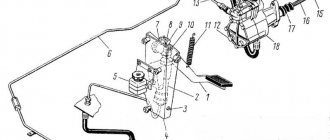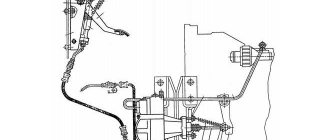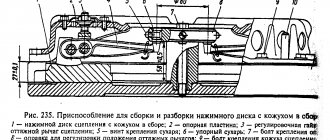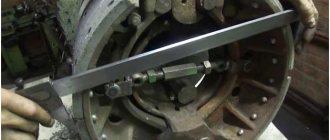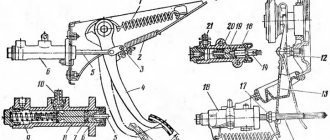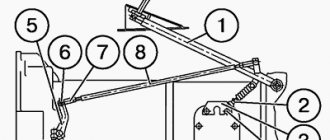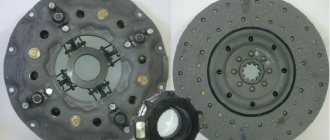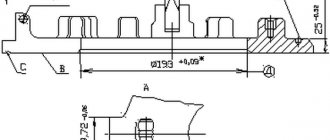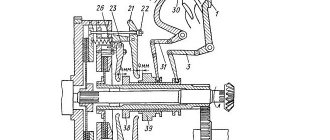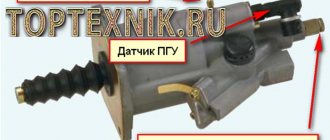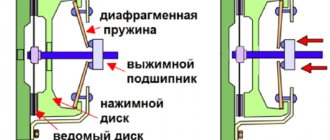Do-it-yourself KAMAZ clutch replacement
To replace the clutch yourself, you will need help removing the gearbox.
Work order:
- Unscrew the fastening nuts, remove the cardan, pneumatic hydraulic booster, and release the starter from the mounting.
- Remove the pipes for the reduction gear, as well as the gear lever.
- Take a jack.
- Place a jack under the engine sump and lift the engine.
- Remove the rear cross member and the spacer rod.
- Release the bracket from the fastening.
- Secure the hoist and tighten it.
- Remove the engine side mounts. Unscrew the gearbox fasteners to the engine.
- Using a hoist, move the gearbox away from the engine until the input shaft comes out, then remove it.
Debugging the full stroke of the amplifier pusher
Before starting to debug the mechanism, it is necessary to find out the stroke length of the pusher. To do this, you need to completely disengage the clutch and measure the stroke. If its value is 25 mm or less, then the clutch will not disengage completely. The driver will notice this problem immediately by the difficulty of shifting gears. To find the cause of the problem, you need to check the level of working fluid in the pusher cylinder. The standard volume is 380 cubic meters. see. If the level of the substance is insufficient, it should be topped up.
Hydraulic system diagram
Using the KamAZ 5511 model as an example, adding fluid is done as follows:
- You need to open the reservoir cap located on the drive housing.
- Add liquid to a level 15-20 mm below the edge of the neck.
The second reason for unsatisfactory operation of the amplifier may be air in the system. In this case, the drive system must be bled. This procedure is somewhat more complicated.
On KamAZ 55102 for this you need:
- Add fluid to normal level.
- Remove the protective cap from the bypass valve (installed on the CCGT housing), put on a rubber hose and lower it into a container with liquid.
- Sharply press the clutch pedal all the way.
- Open the valve one turn and press the pedal until the substance stops bubbling at the outlet of the hose. In this case, it is necessary to constantly add new fluid to the supply tank, not allowing it to fall below the 40 mm mark from the top of the tank.
- Close the valve, remove the hose and replace the cap.
- Add fluid to the operating level.
- To control the quality of work, you must press the pedal all the way - the pusher stroke should not be less than 25 mm.
How to remove the clutch basket
Repairing the KAMAZ clutch basket with your own hands involves removing it. It includes the flywheel, pressure plate and protective cover. The driven part is made of steel discs that dampen vibrations.
Repairing the KAMAZ clutch basket requires its preliminary removal. To do this, you need to screw 4 bolts into the pressure disk and press the disk into the casing. Using pliers, you should carefully press out the antennae on the lock washers, then remove the elements with which the casing is attached to the flywheel, then remove the discs and clutch casing in turn.
Before repairing the KAMAZ clutch and removing the clutch basket, it is necessary to use a core to mark the location of the basket and the flywheel.
Why is KamAZ equipped with a double-disc clutch?
Many people confuse even clutch engagement with a double-disc clutch with smooth clutch engagement, which is a mistake. After all, in this case there is no need to talk about a smooth ride or pick-up. To achieve comfortable handling, the driver must have solid experience. In addition, the KamAZ clutch uses a lightweight flywheel, which slows down gear shifting, and therefore nodding while driving is inevitable. Extraneous noises and crackling noises may also be observed as the speed increases.
What are the advantages of a double-disc clutch? Several points can be highlighted here:
In order for the double-disc clutch to provide the expected result of KamAZ operation, it is necessary to balance not only the flywheel, but also the crankshaft. Adjustment will also be required after the vehicle has been driven for a long time. The driver can do this independently, or by contacting a car service center.
Source
Removing the clutch discs
Replacing a KAMAZ clutch disc requires its removal. KAMAZ has a friction 2-disc clutch, pressure springs and a device for automatically bringing the middle drive disk to the middle position.
When removing the flywheel, it is necessary to take into account the specifics of its design: the drive middle disk is installed in the grooves of the flywheel, which are located around the circumference of this disk. To ensure heat dissipation in the clutch and its ventilation, the disc in its “body” has holes that separate the ribs (spikes). These cleats have a lever that adjusts the position of the driving middle disc. Both the pressure and middle drive disks are located on spikes in grooves located in the flywheel.
The other side of the disk has protrusions that are designed for pressure springs. You should remember the order in which they are placed. The driven disk includes a hub, a spring, a rivet, linings, and a torque vibration damper. The hub with the disk does not have a rigid connection, there are only 8 springs. The space between the driven and driving disks is where the release springs are located, as well as the intermediate disk adjusting bolt.
KamAZ double-disc friction clutch is the driving force of trucks
The main element of a car’s transmission is the clutch, which, on the one hand, serves to protect the engine from damping vibrations and overloads, and on the other, ensures the connection of the driving units when changing gears. Trucks use a double-disc, or friction, clutch, which operates due to the friction force from torque and allows you to increase the service life of the unit. The friction itself is provided by two driven disks, between which there is a spacer, which provides 4 surfaces of working contact.
Assembly of parts and their replacement
Installing and replacing a double-disc clutch on a KAMAZ is a simple process. Common types of damage to the driven and pressure disks are cracks on their surfaces, on the linings, wear of the rings and linings, curvature of the disk, deterioration of the hub fastening, damage to the rivets, and scuffing on the disk surfaces. Replacing used gaskets with new ones requires removing old rivets. Disks that have become unusable also need to be replaced.
Not every car owner knows how to properly install clutch discs on a KAMAZ. There is a certain procedure.
The first of the driven disks is installed with the long end of its hub to the motor, and the second - with the same end to the gearbox. Before tightening the basket, the discs must be balanced.
As the linings on the driven disks wear out, as well as their replacement, the clutch drive should be adjusted, as well as the free play of the clutch.
Design features of the clutch
The bulk of KamAZ trucks use a double-disc clutch with a radial arrangement of power springs. To operate the mechanism, a hydraulic drive with a pneumatic amplifier is used. Thanks to this design, the force required to press the clutch pedal is significantly reduced. During the operation of KamAZ, wear occurs on the clutch discs, which must be compensated for by adjustment. Correct adjustment of the mechanism ensures the fuel consumption declared by the factory and confident acceleration of an empty or loaded vehicle.
KamAZ clutch drive mechanism diagram
The main components of the drive, which is shown in the photo, are:
- pedal (1);
- hydraulic unit (2) with reservoir (3);
- highway (6);
- executive pneumatic cylinder (16).
The KamAZ clutch of models 55111, 5320, as well as 43118 and 740 consists of the following structural units:
- clutch housing (A);
- release disc with stamped metal casing (B);
- pressure springs (B) and levers (D);
- one drive disk (E);
- two driven disks (D) with linings (W).
Clutch diagram for KamAZ 740 with diesel engine
The driven discs in the clutch design of a KamAZ truck are made using heat-resistant friction linings, which ensure a long service life of the mechanism. The design of the disks provides a damper for vibrations that occur when the motor shaft rotates. The drive pedal is mounted on special bushings and rarely requires lubrication during operation.
On more modern KamAZ models, single-disc clutches of the so-called Euro type are used. This mechanism is found, for example, on models 6520 or 4308. The supplier of elements for such units is Sachs, and amplifiers made by Wabco are used. There are several clutch models that differ in the amount of transmitted torque. One of the differences between imported amplifiers is the built-in indicator of friction lining wear. Wear is measured by the distance between the amplifier body and the washer on the rod. When the linings are completely worn out, this distance ranges from 23 to 25 mm. In this case, driving a car is still possible, but repair work must be carried out urgently.
Wabco CCGT unit, the wear indicator rod is visible in the upper left part
On some KamAZ models, for example, on 43114, there may be a PGU manufactured by the Volchansky Automotive Unit Plant, in which there is no possibility of adjusting the rod. Typically, such a PGU is either replaced with a customizable one or another rod with adjustability is installed.
How to repair a KAMAZ clutch
Repair of the KAMAZ clutch cylinder should be carried out after the problem with the tightness of the PGU and its pumping has been eliminated.
After bleeding is completed, press the clutch pedal, turn the air bleed valve all the way, and then remove the hose from the head of this valve and put on the cap for protection.
The fluid level inside the master cylinder is then set to the correct level. Repair of the KAMAZ clutch master cylinder and replacement of the KAMAZ clutch master cylinder imply this operation as mandatory. The brake fluid released from the hydraulic system during bleeding can be used again after it has settled and further filtered. The quality of pumping is determined by the stroke of the pneumatic hydraulic booster pusher.
It is necessary to check the presence of condensation inside the power cylinder of the pneumatic hydraulic booster. To drain the condensate, you need to unscrew the plug of the aluminum housing of the pneumatic power steering. To drain completely, lightly press the clutch (pedal).
At least once every 3 years, the hydraulic system in the clutch drive should be flushed with methanol or brake fluid, the master cylinder and pneumatic hydraulic booster should be disassembled, and fresh brake fluid should be added.
Replacement and repair of clutch KAMAZ TRUCK.BIZ
Replacing the VAZ Classic clutch master cylinder
To replace the clutch on your own, you will need helpers to remove the gearbox.
Work order:
- Unscrew the fastening nuts, remove the cardan, pneumatic hydraulic booster, and release the starter from the mounting.
- Remove the pipes for the reduction gear, as well as the gear lever.
- Take a jack.
- Place a jack under the engine sump and lift the engine.
- Remove the rear cross member and the spacer rod.
- Release the bracket from the fastening.
- Secure the hoist and tighten it.
- Remove the engine side mounts. Unscrew the gearbox fasteners to the engine.
- Using a hoist, move the gearbox away from the engine until the input shaft comes out, then remove it.
How to remove the clutch basket
Repairing the KAMAZ clutch basket with your own hands involves removing it. It includes the flywheel, pressure plate and protective cover. The driven part is made of steel discs that dampen vibrations.
Repairing the KAMAZ clutch basket requires its preliminary removal. To do this, you need to screw 4 bolts into the pressure disk and press the disk into the casing. Using pliers, you should carefully press out the antennae on the lock washers, then remove the elements with which the casing is attached to the flywheel, then remove the discs and clutch casing in turn.
Before repairing the KAMAZ clutch and removing the clutch basket, it is necessary to use a core to mark the location of the basket and the flywheel.
Removing the clutch discs
Replacing a KAMAZ clutch disc requires its removal. KAMAZ has a friction 2-disc clutch, pressure springs and a device for automatically bringing the middle drive disk to the middle position.
When removing the flywheel, it is necessary to take into account the specifics of its design: the drive middle disk is installed in the grooves of the flywheel, which are located around the circumference of this disk.
To ensure heat dissipation in the clutch and its ventilation, the disc in its “body” has holes that separate the ribs (spikes). These cleats have a lever that adjusts the position of the driving middle disc.
Both the pressure and middle drive disks are located on spikes in grooves located in the flywheel.
The other side of the disk has protrusions that are designed for pressure springs. You should remember the order in which they are placed. The driven disk includes a hub, a spring, a rivet, linings, and a torque vibration damper.
The hub with the disk does not have a rigid connection, there are only 8 springs. The space between the driven and driving disks is where the release springs are located, as well as the intermediate disk adjusting bolt.
Assembly of parts and their replacement
Installing and replacing a double-disc clutch on a KAMAZ is a simple process.
Common types of damage to the driven and pressure disks are cracks on their surfaces, on the linings, wear of the rings and linings, curvature of the disk, deterioration of the hub fastening, damage to the rivets, and scuffing on the disk surfaces. Replacing used gaskets with new ones requires removing old rivets. Disks that have become unusable also need to be replaced.
Not every car owner knows how to properly install clutch discs on a KAMAZ. There is a certain procedure.
As the linings on the driven disks wear out, as well as their replacement, the clutch drive should be adjusted, as well as the free play of the clutch.
How to repair a KAMAZ clutch
Repair of the KAMAZ clutch cylinder should be carried out after the problem with the tightness of the PGU and its pumping has been eliminated.
After bleeding is completed, press the clutch pedal, turn the air bleed valve all the way, and then remove the hose from the head of this valve and put on the cap for protection.
The fluid level inside the master cylinder is then set to the correct level. Repair of the KAMAZ clutch master cylinder and replacement of the KAMAZ clutch master cylinder imply this operation as mandatory.
The brake fluid released from the hydraulic system during bleeding can be used again after it has settled and further filtered.
The quality of pumping is determined by the stroke of the pneumatic hydraulic booster pusher.
It is necessary to check the presence of condensation inside the power cylinder of the pneumatic hydraulic booster. To drain the condensate, you need to unscrew the plug of the aluminum housing of the pneumatic power steering. To drain completely, lightly press the clutch (pedal).
At least once every 3 years, the hydraulic system in the clutch drive should be flushed with methanol or brake fluid, the master cylinder and pneumatic hydraulic booster should be disassembled, and fresh brake fluid should be added.
Classification of processes and functionality
The gear shifting process is fundamental to the vehicle control system. It is thanks to the serviceability of the release mechanisms that the car begins to move, gears change, and a stop occurs. Without proper operation of this unit, further operation of any Kamaz model will be simply impossible. Therefore, it is very important to maintain this mechanism in proper condition. Many workflows can be classified into several main points of servicing a high-load node.
- Systems differ in how they are controlled. There are various options, for example, mechanical, hydraulic, electric, mixed drive types.
- The types of friction are also different. Among others, they are either dry (wear-resistant gaskets are surrounded exclusively by air) or wet - the principle of movement is determined by the oil system.
- The activation mode varies. The circuits can be permanently closed, or intermittently (closed exclusively during operation).
- The number of driven discs varies depending on the car model. The simplest systems contain only one slave, more complex ones contain several.
- Highly loaded units differ in type and location of the pressure spring. There can be several of these types, peripherally located, or through one diaphragm central spring.
- The torque transfer flows for engine components can vary numerically; there are single-flow and double-flow types.
This classification is an example of the diverse structure of various KamAZ models. Thanks to the modernization of engines, especially after the transition to the Euro type classification, the gear shift processes have changed slightly, but the components have remained the same.
Conditions for installing disks
After pressing the pedal using a mechanical or hydraulic pressure system, the drive disk is separated from the driven one. This process occurs due to the force transmitted from the pressure system mechanism to the fork, clutch, levers, fingers, which retract the pressure system to a certain distance. In parallel with this process, the springs are compressed, forming the necessary gaps. If the clutch type is double-disc, the necessary clearances are created by the release springs together with the adjusting bolt.
At the moment of pressing, the engine is disconnected from the box, so the rotation torque occurs separately from the transmission. If you release the pedal, the discs will compress tightly. By releasing the pedal, the driver starts the process of returning all components to their original position due to the return to the state of the springs, the driven one will again press against the pressure one.
Adjusting the Kamaz double-disc clutch without removing the gearbox
The upper hatch of the clutch housing allows you to do this. The stoppers are removed one by one from the adjusting nuts. Then the paws are released. Through the hatch you can see the gap between the ring and the release bearing. The release bearing must be moved away from the basket. The lever on which the PSU rod presses must take a vertical position. In this position, the PSU operates correctly and is easily adjusted. The plane of the release bearing will become clearly visible. After this, the paws are brought in. You can use a wire with a diameter of 3 m. Insert it between the ring and the release ring. When bringing the paws in, the wire should not be pinched too much. It’s not convenient to adjust each foot this way. But much easier than removing the gearbox.
Therefore, if the question arises about how to properly adjust the clutch, I do not recommend setting the gap to 57 mm.
Additional adjustments
The rest of the Kamaz clutch adjustment consists of maintaining the gaps between the release bearing and the pressure ring. It is 1.5 - 3 mm. The gap is adjusted by moving the PSU rod. The lock nut unscrews and the rod rotates. Here it is not necessary to go to the release bearing and measure the clearance on it. It is enough that a slight play appears on the release fork rod. You can hear the release fork hitting the ring. When pressing the fork.
Possible causes of malfunctions
The most popular clutch “disease” is the occurrence of slipping. This problem is also called "incomplete inclusion". This name is derived from a number of technical processes - when the pedal is not pressed, the discs can slip relative to each other. This process changes the operating temperature of the entire assembly; when operating at incorrect temperatures, the slave may become deformed, and the master may become covered with cracks. Due to high temperatures, wear linings begin to burn, creating an unpleasant smell of burnt rubber.
This malfunction is best diagnosed in high gears, because the gear increases, but the speed remains unchanged, reaching a certain level. To get the system functioning again, it is necessary to replace the non-functioning components of the push mechanism.
